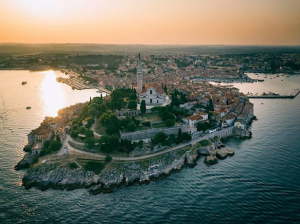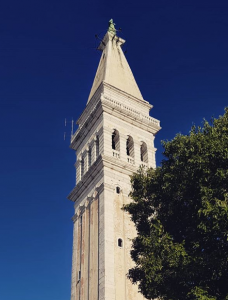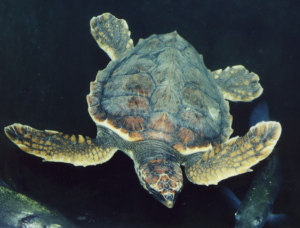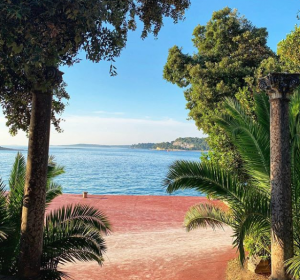Rovinj Sights
The Old Town Centre

The inner town is packed onto a small island (actually a limestone rock) which dictated its shape. Its steep, narrow and winding main street with covered passageways and small squares, reveals, more than other Istrian towns, the peasant character of a medieval settlement. The closely-packed agglomeration of houses, high and narrow, ascends stepwise to the hilltop, where the Church of St. Euphemia (Sveta Eufemija) stands.
The town centre has been surrounded by a wall since the Dark Ages and is entered through seven gateways, of which three have retained their original appearance. The Balbi Arch, (Luk Balbi) today’s city gate – is a Venetian construction built in 1680 on the site of the old town gates. From it leads Bregovita Street (Bregovita ulica), picturesque and interesting, built in the 18th century with covered passageways and frescoes below the eaves. There is an openair art exhibition every year in Grizia Street (Grizia ulica).
The Church of St. Euphemia (Crkva Svete Eufemije or Svete Fume)

It stands on the hilltop. It was built on the foundations of an early Christian church, St. George (Sveti Juraj), whose first phase dates from the 5th and 6th centuries, and second phase from the 9th and 10th centuries. The present parish church is Baroque, (nave and two aisles), built according to the plans of the Venetian architect Giovanni Dizzi during the second and third decades of the 18th century. It was consecrated in 1756. It is a church of pilgrimage, especially on its Saint’s day (16th September) when believers and travellers from all over Istria gather there. The bell tower is a copy of the one at St. Mark’s in Venice, built about 70 years before the church. It took 26 years to build, is 60 m high and is the tallest in Istria. In 1758 a large statue of St. Euphemia was placed on its spire. The statue is fixed on bearings so that it turns according to the direction of the wind. Inside the church, the most interesting item is the sarcophagus with the body of St. Euphemia. It is a stone sarcophagus in late Classical style, according to 4th and 5th century models. It contains the preserved body of the Saint. According to legend, she was tortured in Chalcedon (near Constantinople) during the reign of Diocletian (304) in various ways, and finally on a wheel with knives, after which she was thrown to the lions, who would not touch her. When Chalcedon was conquered by the Turks her body was brought to Constantinople. During the Iconoclastic Controversy (800), according to Church tradition, her body disappeared from Constantinople and was washed up on the beach near Rovinj on 13th July, 800. The story is illustrated on the wall near the sarcophagus. The church also has other valuable treasures: The Last Supper by Titian’s successor, Giovanni Contarini (1574) and the paintings Christ in the Garden of Gethsemane and The Sleeping Apostles, both of which originate from Venice. The sculptures in the church are the work of the Venetian sculptor Gerolamo Laureato. The church also has a rich silver collection. These are the remains of a rich inventory which was confiscated by the Fraternities during the rule of the French (1805). In the sanctuary, which dates from 1803, there are several valuable paintings by E. Zanfurnari.
The Baptistery
It stands on Freedom Square (Trg Slobode) near the bus station in the southern part of the town. It is a heptagonal Romanesque chapel of the Church of the Holy Trinity (Crkva Presvetog Trojstva) built towards the end of the 12th century. It has all the characteristics of Romanesque architecture: from the outside it is heptagonal, on the inside it is circular with seven niches and a dome. Light enters through three openings on the outside which lend a special harmony to this small structure. Inside the baptistery there is a stone screen with scenes of Golgotha, the Madonna, St. Peter and John the Baptist.
The Franciscan Monastery
This stands on the top of the hill which faces the old towncentre of Rovinj. Both the monastery and the church were built at the beginning of the 18th century in the Baroque style. The monastery was started in 1702. In the monastery there is a museum which was founded in 1979 and houses a beautiful collection of ecclesiastical robes, icons, paintings and sculptures from the 18th to the 19th centuries. There is a valuable collection of illuminated manuscripts and liturgical equipment. The monastery also possesses a rich collection of old books.
Holy Cross Church ( Sv. Kriza)
It stands right next to the old town gates, and was built in the 14th century. A vestibule was added in 1492.
The Folk Museum (Zavicajni muzej)
It was founded in 1954 and houses the following collections: an archaeological collection; a collection of documents relating to modern history; an ethnographic collection and a gallery of old masters from the 16th to the 19th centuries, with over 250 works of art. The museum also has a rich library, including the library of the Istrian historian Petar Stankovic (from the turn of the 18th and 19th centuries). There are also occasional art exhibitions in the museum, and there is a collection of paintings by the contemporary Croatian painter Vilko Seferov.
The Aquarium

The Aquarium of the Ruder Boskovic Centre for Marine Research is housed in a building which has served this purpose for more than 100 years. There are examples of flora and fauna from the sea around Rovinj, the Northern Adriatic and the western coast of Istria.
Zlatni Rt
To the south of Rovinj, in the suburb called Zlatni Rt (Punta Corrente, the Golden Point) there is now a park which was set up in 1890, with exotic trees. This was the site of an ancient stone quarry right up until the 18th century. Stone from here was used to build the Doge’s palace in Venice and the famous Church of Santa Maria della Salute.
Red Island

Red Island (Crveni Otok) lies to the south of the Muntrav point and actually consists of two islands – St. Andrew (sv. Andrija) and Maskin – which are joined by a harbour wall. They lie 1.5 nautical miles by boat from Rovinj town harbour. The island has an exceptionally mild climate, and is completely covered with evergreen vegetation, especially myrtle and bay. It was inhabited in prehistoric times. There are visible remains of the Roman era in the sea and on the beach. In the 6th or 7th century a church was built on the island in the shape of a Greek cross with a semicircular apse. There used to be a monastery there too, or at least a hospice, as early as the 6th century, at a time of very strong links between Istria and Ravenna, during the time of Justinian’s reconquests. The monastery was founded by Archbishop Maximilian, who was born in Vestar, not far from Rovinj, and who later donated his family estates to the monastery. It was held by the Benedictines until the 13th century, then in the middle of the 15th century the Franciscans renovated it once it had become deserted. Its first guardian following this restoration was St. John of Capistrano (1386-1456) who defended Belgrade in 1456, when the Turks suffered a heavy defeat. In memory of this Christian victory, the custom of ringing the church bell in the afternoon was introduced, at the time when the news reached Rome. The Franciscans held the monastery until 1809 when their leaders removed them from the island. In 1820 the island was privately owned. The monastery and church suffered severe damage in 1852 when the whole complex was converted into an oil mill, and then an even worse fate when it was turned into a cement factory – the church bell tower serving as a chimney. In 1890 the island was sold to Baron Ivan Georg Hütterodt, who turned it into a park and restored the monastery buildings. In the chapel and the castle on the island there is an exhibition of paintings by Aleksandar Kirchner showing the development of the Austrian merchant fleet and navy. There is also a display on the development of seafaring and fishing in Rovinj. In the chapel there is a collection of Istrian frescoes.
The Rovinj Coast
Western Istria as a whole is considered to have special natural characteristics (Red Istria), but the area around Rovinj has unusual features which set it apart as an area of natural interest, and it is therefore protected. The jagged coastline is backed by extraordinarily rich natural forests of pubescent oak (Quercus pubescens) and holm oak (Quercus ilex) as well as plantations of pine forests. The most valuable of Rovinj’s natural beauty spots are the parks on Zlatni Rt (Punta Corrente, Golden Point) and by the hospital. Both were planted at the beginning of this century. On Zlatni Rt particularly significant are: the avenue of cypresses (Cupressus sempervirens), the Italian stone pines (Pinus pinea), the cedars (Cedrus sp.) and copses of Aleppo pines (Pinus halepensis), silver firs (Abies alba), holm oak and other exotic trees.
City’s History
The Prehistoric Period
Archaeological finds show that Rovinj and its surrounding area (Rovinjstina) were inhabited in prehistoric times. Like the rest of Istria, Rovinjstina was settled by the Illyrians, the Histri. The topographic features of the settlement (Rovinj was an island right down to the 18th century, with a natural wall of rock to the west) made it easily defensible from the sea, and allowed access to the nearby mainland. Even before Roman times, Rovinj was a fortified town.
The Roman Era
The Romans finally conquered Istria in 177 BC. On the foundations of the old Illyrian settlement, they built their own Ruginium but it remained an insignificant place throughout the entire Roman era. When the Empire was divided, Rovinj, along with the whole of Istria, came under the Eastern Empire.
Under Various Rulers
Under Byzantine rule, Rovinj was part of the Exarchate of Ravenna (from the 6th century) and from 788 part of the Frankish state. Anonymous of Ravenna mentioned the town in the 8th century as Ruginio, or Rugino. The Slavs, who settled in lstria from the 7th century, called the settlement Rovinj. Being on the coast, it was the target of frequent attacks. For this reason in the Middle Ages it had to be protected by walls. In the 9th century the Neretvans threatened the town many times in their campaigns along the western coast of lstria, and in 876 they pillaged it and set it alight. From the One of the 10th to the 12th centuries the citizens of Rovinj developed their own self-governing communal system: an assembly of townspeople (arenga) and a Great Council. Various noble families ruled the town for three centuries, and in 1209 it came under the authority of the Patriarchs of Aquileia.
Under the Venetians
Rovinj was one of the first Istrian towns to fall under the Venetians, in 1283. Venice restricted and then abolished the town’s self-government, and brought in a “podesta” who was always a Venetian nobleman. During the wars between Genoa and Venice, the Genoans sacked the town, and after the fierce battle of 1379 the town strengthened its surrounding walls. In 1559 and 1599 Rovinj was attacked by the Uskoks of of Senj and they subsequently sacked and burnt the town as belonging to their Venetian enemies. Rovinj also suffered from frequent outbreaks of plague, which often struck Istria, but these plagues also contributed to urban development. Many families fled to Rovinj from various other towns in Istria in the 17th century to escape infectious diseases. Thus Rovinj developed within the city walls, and later also extended beyond them. Once the danger from the pirates and the Turks had passed (end of the 17th century) Rovinj spread further beyond the old town centre. At the beginning of the 17th century, the neighbouring hill on the mainland was also built up and in 1710 a church and monastery dedicated to St. Francis (SvetiFranjo) were built. In 1763 the channel between island and mainland was filled in.
The last two hundred years
After the fall of Venice in 1797 the townspeople of Rovinj chose 18 representatives from an assembly of all the male heads of families (of whom there were 1,016), who took on the administration of the town. They remained in power, with a few alterations, until 1813 when the Illyrian provinces were abolished. Up to the second half of the 19th century, Rovinj was the biggest town and harbour on the western Istrian coast. Once Trieste and Pula began to grow and become more important, Rovinj stagnated, that is, it had the same number of inhabitants as in the 18th century. The opening of the tobacco factory in 1872 brought a little life and economic growth to the town, and a year later it gained a railway link to the Divaca – Pula line. Between the two wars Rovinj stagnated once more, and again the population failed to increase, but after World War II it once again knew a period of prosperity.
